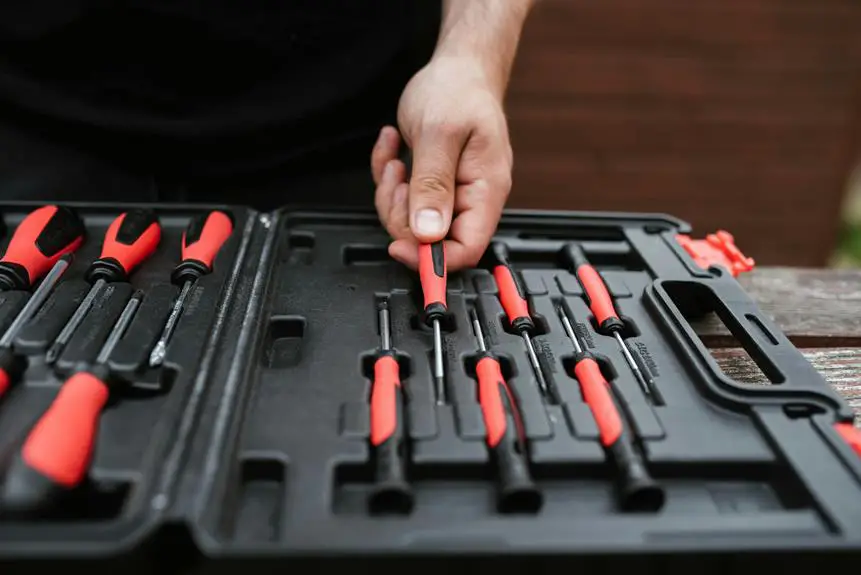When you're selecting rivets for your fabrics, it's crucial to consider both the material and the rivet type. You wouldn't want to use heavy-duty metal rivets on delicate fabrics, as that could lead to damage. Instead, understanding the properties of your fabric and matching them with the right rivet can enhance both durability and style. Take a moment to assess the thickness and texture of your fabric—this could change everything. What happens when you choose the wrong rivet? The answer might surprise you.
Table of Contents
Key Takeaways
- Assess fabric type: Choose metal rivets for heavy fabrics like denim and leather, while lighter fabrics like satin work best with plastic rivets.
- Measure fabric thickness: Select rivet sizes that adequately secure layers without excessive protrusion or weakness.
- Consider rivet material: Use corrosion-resistant materials for outdoor projects to ensure durability and longevity.
- Match rivet aesthetics: Select finishes and colors that complement your fabric while maintaining care requirements, like rust resistance for moisture-prone items.
Understanding Rivet Types
When you choose rivets for fabrics, it's crucial to understand the different types available and how they can impact your project. Rivets come in various materials, including metal, plastic, and even fabric-covered options. Each type serves different purposes and offers unique benefits.
Metal rivets are the most common. They provide durability and a classic aesthetic, making them ideal for heavy-duty applications. You'll find options like copper, brass, and aluminum, each with distinct finishes and strengths.
Plastic rivets, on the other hand, are lightweight and often used for projects where weight matters, such as fashion accessories.
Then, there are specialty rivets like decorative or capped rivets. These add a stylish touch to your fabric projects, elevating their overall appearance. If you're working on outdoor gear, consider corrosion-resistant rivets to ensure longevity.
Think about the installation method, too. Some rivets require special tools, while others can be applied with simple hand tools. Understanding these nuances will help you select the right type for your fabric, ensuring your project not only looks great but also holds up over time.
Choose wisely to achieve the best results!
Assessing Fabric Compatibility
Assessing fabric compatibility is essential to ensure that the rivets you choose will securely attach without damaging or distorting the material. Different fabrics have unique properties, and understanding these can guide you in selecting the right rivets.
To help you identify suitable rivets for various fabrics, consider the following table:
| Fabric Type | Recommended Rivet Type |
|---|---|
| Denim | Steel or Copper Rivets |
| Canvas | Aluminum Rivets |
| Leather | Brass Rivets |
| Satin | Plastic or Light Metal |
| Cotton | Stainless Steel Rivets |
When choosing rivets, think about the fabric's weight and texture. For heavier fabrics like denim or canvas, sturdier rivets are essential to handle stress and wear. On the other hand, lighter materials like satin may require gentler options to avoid tearing. Always test a small area if you're unsure about compatibility. This way, you can ensure the rivets will hold without compromising the fabric's integrity. Make informed choices, and you'll achieve a polished, professional finish on your projects.
Evaluating Rivet Sizes
Choosing the right rivet size is crucial for ensuring a secure and aesthetically pleasing attachment to your fabric. Start by measuring the thickness of the material you're working with.
Rivets come in various lengths and diameters, so it's essential to match the rivet size to your fabric's thickness. A rivet that's too short won't secure the layers adequately, while one that's too long may protrude awkwardly, compromising both appearance and functionality.
Next, consider the diameter of the rivet. A larger diameter provides more surface area, which can distribute stress better but might also create bulkiness. For lightweight fabrics, a smaller diameter rivet often works best, as it won't overwhelm the material.
Don't forget to think about the rivet's intended function. If your project involves heavy stress or frequent movement, opt for a larger and sturdier rivet.
Lastly, always test a few rivet sizes on scrap fabric before committing to your final choice, ensuring that you achieve the perfect balance between strength and style. By carefully evaluating rivet sizes, you'll enhance both the durability and appearance of your fabric project.
Selecting Materials and Finishes
Selecting the right materials and finishes for your rivets can significantly impact both the durability and appearance of your fabric project.
To start, consider the fabric type you're using. If you're working with heavy materials like denim or leather, opt for robust metals like brass or stainless steel that can withstand wear and tear. For lighter fabrics, aluminum or plastic rivets might suffice.
Next, think about the finish. A polished finish can give your project a sleek, professional look, while a matte finish offers a more subtle appearance. If you want to add a touch of style, explore colored or coated rivets that complement your fabric. Just make sure these finishes are compatible with the fabric's care requirements—some finishes mightn't hold up well in washing or exposure to sunlight.
Also, consider the environment where your project will be used. If it's exposed to moisture, look for rust-resistant options.
Application Techniques and Tips
After picking out the right materials and finishes for your rivets, it's time to focus on the best application techniques to ensure a strong and secure attachment. Start by gathering your tools: a rivet setter, hammer, and any other necessary supplies. Make sure to mark where you'll place each rivet on your fabric for precision.
Here are some key tips to keep in mind:
| Step | Tips |
|---|---|
| Fabric Preparation | Prewash and iron fabric to avoid shrinkage. |
| Marking | Use a fabric marker for clear placement. |
| Punching Holes | Create holes slightly larger than the rivet shaft. |
| Setting Rivets | Apply even pressure when using the rivet setter. |
| Final Inspection | Check for secure attachment and any fabric damage. |
Frequently Asked Questions
Can Rivets Be Removed and Reused Without Damaging the Fabric?
Yes, you can remove rivets without damaging the fabric if you're careful. Use the right tools and techniques to minimize stress on the material, ensuring both the rivet and fabric stay intact for future use.
What Tools Are Necessary for Installing Rivets on Fabrics?
To install rivets on fabrics, you'll need a rivet setter, a hammer or a press, and a cutting tool for the fabric. It's essential to have a sturdy surface for accurate installation and support.
Are There Specific Rivet Brands That Are More Reliable?
Absolutely, some rivet brands stand out for their reliability. You might consider brands like Tandy Leather or Dritz, known for quality and durability. They ensure your projects withstand wear and tear while maintaining a polished look.
How Do I Care for Fabric Items With Rivets?
To care for fabric items with rivets, you should gently hand wash them, avoid harsh detergents, and air dry. Regularly check rivets for rust or damage, and clean them with a soft cloth if needed.
Can Rivets Be Used on Stretchy or Elastic Fabrics?
Yes, you can use rivets on stretchy or elastic fabrics, but you'll need to choose the right type. Ensure they're securely attached without compromising the fabric's stretch, allowing for flexibility and comfort in your design.
- Does Cotton Polyester Fabric Wrinkle? (And How to Fix It) - June 23, 2025
- Why Poly-Cotton Is the Go-To Fabric for T-Shirts and Hoodies - June 23, 2025
- 50/50 Cotton Polyester Blend vs. 100% Cotton: An Ultimate Showdown - June 23, 2025







